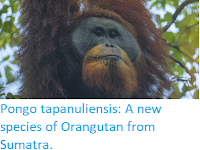A survey carried out by the Greater Virunga Transboundary Collaboration, published on Monday 16 December 2019, has found that the population of Mountain Gorillas,
Gorilla beringei beringei, living within the Bwindi-Sarambwe ecosystem (i.e. the Bwindi Impenetrable Forest National Park and Sarambwe Nature Reserve in Uganda) has increased from an estimated 400 individuals in 2011 to an estimated 459 individuals in 2019. This supports another recent survey in the Virungu National Park which also suggests an ongoing upward trend in Mountain Gorilla numbers, with the total number of individuals estimated to be living in the wild across the Democratic Republic of Congo, Uganda, and Rwanda now standing at 1063.
A Mountain Gorilla in the Sarambwe Nature Reserve. Greater Virunga Transboundary Collaboration.
The Mountain Gorilla is considered to be Critically Endangered under the terms of the International Union for the Conservation of Nature's Red List of Threatened Species, and have been subject to extensive conservation measures and regular monitoring since the 1970s, with the effect that their population is currently thought to be slowly increasing steadily since the population reached a low point of about 280 individuals in the mid 1980s. The population is fragmented into several different populations which are no longer able to interbreed, due to the clearance of forests to create farmland, which the Gorillas are unable to cross.
A family of Gorillas in the Bwindi Impenetrable Forest National Park. Gorilla Doctors.
See also...
Follow Sciency Thoughts on Facebook.








